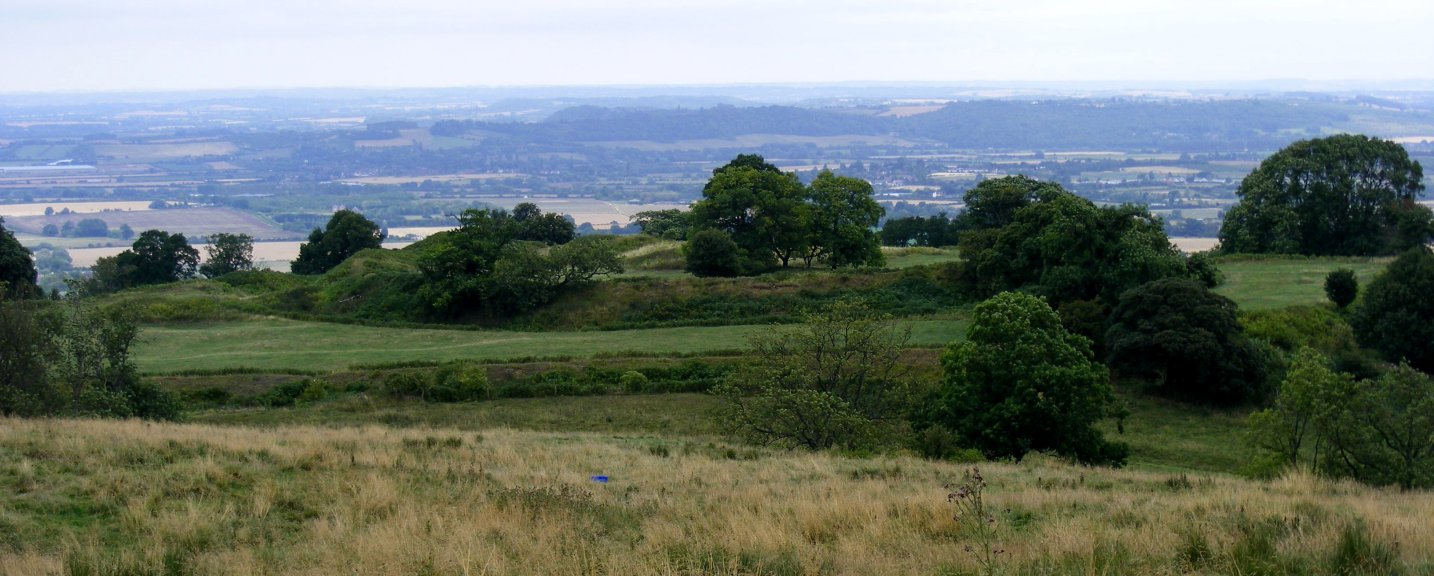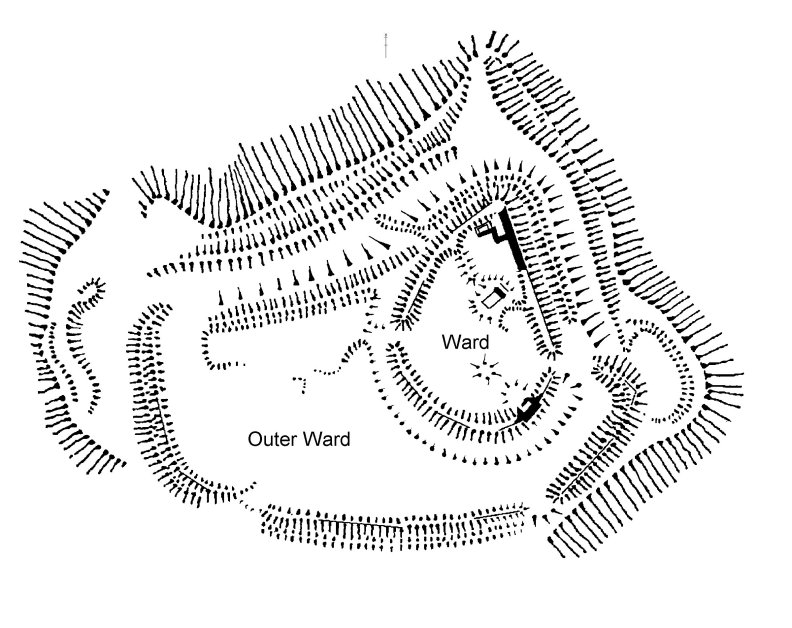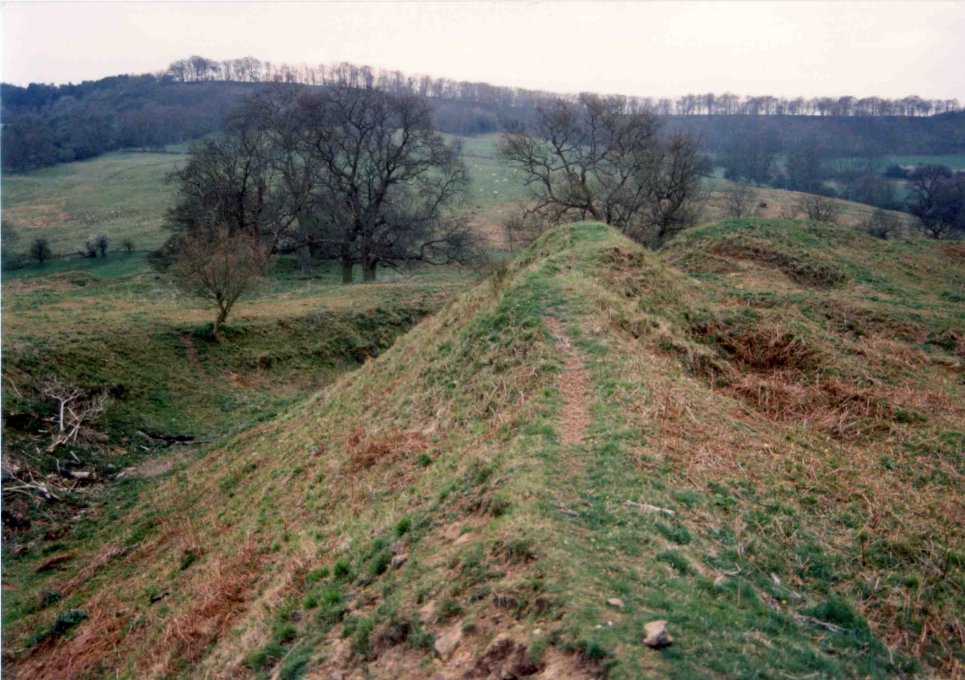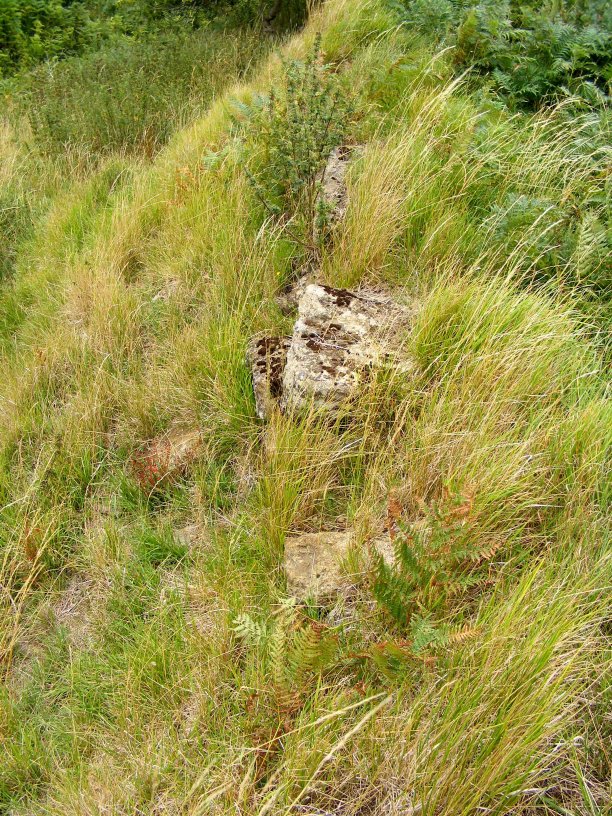Elmley

After 1114, the Beauchamp family would appear to have made Elmley
castle their caput and as such became known as Beauchamp of Elmley, to
differentiate themselves from many other cadet families, like the
Scottish Beauchamps, the Bedford Beauchamps and the Beauchamps of
Hatch. Under their ownership the vill and therefore castle was
recorded under the names Almega, Aumel, Elmeleg, Elmesleg, Hammele, Hammeleg and Haumel.
During the Anarchy (1136-54), William Beauchamp (d.1170), the son of
Walter (d.bef.1133), was lord of Elmley. Initially he supported
the cause of King Stephen (d.1154) and was rewarded with the constableship of the rebel Miles Gloucester (d.1143) on his defection to the Empress Matilda
in 1139. However, William proceeded to argue with the king over
Count Waleran of Meulan (d.1166) being made earl of Worcester and being
granted Worcester castle whose
custodianship had previously been with the hereditary sheriffs of
Worcester, the Abetots and then the Beauchamps. As a consequence
in July 1141 at Oxford, the Empress made William the hereditary constable of Worcester castle
and sheriff of the county just as his father Walter had been.
William also pledged allegiance to the Empress against all mortals and
especially against Count Waleran of Meulan (d.1166).
William became my liege man
against all mortals and particularly against Count Waleran of Meulan,
in such a manner that neither Count Waleran or those aforesaid may make
a fine with me whereby William should not hold of me in chief, unless
of his own free will and consent he wishes to hold of the count.
Further, for his allegiance he was granted the honour of Tamworth
to hold just as freely as Robert Despenser and Urse Abetot had held
it. At this point Count Waleran was in London and then Kent with
Queen Matilda (d.1152), the wife of King Stephen, in opposition to the
Angevins. He later made his peace with the Empress in March/April
1142 and was recognised by her as earl of Worcester. However,
Waleran now withdrew to Normandy and there is no evidence he ever
returned during the disturbances, but left William Beauchamp in charge
of Worcester, nominally in his name. In early 1146 he sent an
order to Beauchamp, which rather suggests that this was the agreement
reached between the 3 at Devizes. In 1149 it was confirmed that
Walter Beauchamp and William his son had granted a tithe of their wine
at Elmley, which in itself suggests that this was already a caput of
the family.
In 1150 King Stephen attacked Worcester
city and burned it, although the castle, under the men of Earl Waleran
Beaumont of Worcester, held out. The king then ‘overran the
territories of the hostile lords and, no one resisting them, carried
off an immense booty'. Presumably one of these hostile lords was
William Beauchamp of Elmley. The next year, 1151, Stephen
returned;
having been unable to reduce
the castle the year before, he now assaulted it with the utmost
determination. As the garrison made a manly resistence, he
constructed two castles to expel them.
According to one chronicle, William Beauchamp was captured at this time by Ralph Manderville [probably of Marshwood,
Dorset]. In any case, during this year, 1151, Earl Robert
Beaumont of Leicester (d.1168), Earl Waleran's younger twin brother,
appeared on the scene and led his brother's forces in
‘demolishing the 2 castles' and breaking the siege. This
was despite the fact that he was still nominally a royalist. It
is possible that one of these ‘siege' castles may have been
Elmley as it was only 13 miles away. The other castle may have
been on the Herefordshire Beacon some 10 miles away. In 1136 it was thought that it was unnecessary to build a siege castle at Harptree as the royal garrison at Bath was sufficient to play that part. Harptree castle is 13 miles from Bath.
The fall of the 2 siege castles would appear to have left Worcester in
the hands of the men of the nominally Angevin Earl Waleran. In
1153 Waleran's knights of Worcester castle were accused of seizing and
imprisoning Sheriff William Beauchamp ‘by trickery'. If
this is correct it shows that the unlucky William had been captured
twice in 2 years. It is uncertain exactly what happened, but
Beauchamp and Earl Roger of Hereford (d.1156) had worked together for
the Angevin cause since the early 1140s. Count Waleran was at
least nominally pledged for the Empress' son, Duke Henry Plantagenet of
Normandy (1133-89) as too by this point may have been his brother, Earl
Robert of Leicester (d.1168). The Angevin Earl Roger of Hereford
now approached King Stephen and offered to join him in reducing
Worcester in ‘a pact of inviolable peace and friendship' and to
rescue his friend, Sheriff William Beauchamp. King Stephen agreed
to the proposal and the allied forces of king and earl of Hereford
besieged Waleran's men within Worcester castle. In an act of
duplicitous treachery Earl Roger then informed Duke Henry of Normandy (1133-89)
of his actions and asked him to come over to England at once.
King Stephen, who was apparently aware of Earl Roger's actions,
therefore left the siege, although he left part of his army to aid the
earl. Worcester castle was duly reduced, but after this Earl
Roger promptly declared again for Duke Henry, breaking his pact with
King Stephen. This act appears to have finally extinguished the
Beaumont earldom of Worcester, though once again the status of William
Beauchamp is unknown, although presumably he was released from his
captivity within Worcester castle. However in 1153, King Stephen
took Tamworth castle from Beauchamp and restored it to Robert
Marmion. King Henry II (d.1189) did not overturn this action of his enemy
once he became his heir and then successor.
William Beauchamp (d.1170) remained loyal to the Angevins and in 1155
was with the royal army besieging Hugh Mortimer (d.1181) at Bridgnorth
castle. During the Anarchy William had married Bertha, the daughter of
William Braose (d.1180, of Radnor, Buellt and Bramber) and Bertha
Hereford the daughter of Earl Miles of Hereford (d.1143) and lord of
Abergavenny. On his death he was buried at the door of Worcester
cathedral chapter house. His son died young in 1197 in Normandy
and his grand uncle, William Braose (d.1211) bought his custody.
William Beauchamp came of age in 1207 and died in 1208, possibly in the
Braose war of that year. At this point his Uncle Robert bought
the custodianship of William's younger brother, Walter (d.1236).
In 1212 he came of age and married Joan (d.1225), the daughter of Roger
Mortimer (d.1214) of Wigmore. During the civil war of
1215-17, Walter was appointed sheriff of Worcester on 19 August 1215 in
the aftermath of the Magna Carta negotiations. Later that year he
obviously fell away from John after 2 February 1216 and joined the
rebellion. On 2 August 1216 Walter received a safe conduct to
visit the king. This meeting obviously took place and on 8 August
the king wrote to William Cantilupe (d.1239) informing him that he
placed Walter Lacy (d.1241, of Longtown, Ludlow), Hugh Mortimer
(d.1226, Wigmore), Walter Clifford (d.1263, Clifford, Bronllys) and
John Monmouth (d.1236, Monmouth) to the custody of Walter Beauchamp's
castle of Elmley and his lands until the excommunicated
Beauchamp can get to the papal legate and receive absolution. At
this time the aforesaid barons would return his castle and lands to
him. As John sent this letter from Oswestry after his Marcher
campaign, it would seem likely that Beauchamp had crumbled before the
king's show of force in the Welsh borders, Elmley castle being an
obvious target of the king's ire. On 19 August 1216, Walter's
seneschal, Richard Vincent was in the custody of Constable Hugh Vivon
of Berkeley castle while the king sojourned at the fortress. From
here onwards the Beauchamps proved loyal to King John's son and heir,
King Henry III (1216-72).
In 1234 King Henry III sent deer to Walter to stock the park he had created
at Elmley. Thirty years later war nearly came to Elmley
castle. During the Barons' War William Beauchamp took the part of
the king. On 5 May 1263, he was ordered to join the royal army
forming at Worcester and in 1265 his sons took part in the battle of
Evesham which was fought within sight of Elmley castle, although the
fortress is not recorded as taking any role in the fighting.
However, the castle's time as caput for this middling baronial family
came to an end in 1268 when William Beauchamp (d.1269) became earl of
Warwick and transferred the family seat to Warwick castle. When
his son, Earl William Beauchamp of Warwick, died on 9 June 1298
Aumelegh castle was found to be in need of much repair. In 1308 a
chantry was founded in the castle chapel that was to be served by 8
chaplains and 4 clerks endowed with £20 from the manor of Childs
Wickham. In 1311 the rectory of Elmley had been added to the
endowment, but it still proved too expensive to run so was reduced by a
chaplain and 2 clerks. In 1312 the captive Piers Gaveston was brought here before being moved to Warwick castle.
When Earl Guy Beauchamp died in 1315, Aumeleye castle was only valued
at 6s 8d although there was a garden within the fortress and fisheries
in the vicinity. A second valuation found the castle as worth
nothing. As Guy's heir was only 1½ years old the king
granted the castle to his executors on condition that they did not
grant it to any others without the king's express licence. These
descriptions show that the castle was not actually derelict, but that
there was no income to support it. This implication is proved by
what happened next.
On 1 December 1316, the king granted Elmley castle to the executors of
Earl Guy Beauchamp's will during the minority of the heir, but had on 2
August 1317 transferred the custody to the senior Hugh Despenser (d.1326) in
part payment of the debt owed him, the castle and manor having been
extended at £49 12s 10½d per annum. On 1 November
1317, Hugh was ordered to have the castle securely guarded and then on
the 22nd to place 20 fencible footmen in Elmelegh castle and retain
them at the king's wages until further orders, paying the wages out of
the farm of the castle. Presumably these men were still at the
castle on 4 June 1321, when the sheriff of Worcester was ordered to
take the body of the castle of Elmley into his hands from those of the
senior Hugh Despenser and to have the fortress safely guarded.
This was on the exile of the Hugh Despensers as was forced on the king
that summer. The sheriff was also to make an indenture of the
arms, victuals and other goods found there before a jury of 12
men. However, the king soon brought the Despensers back with the
result that after Christmas 1321 the kingdom was rocked by an
anti-Despenser riot which caused the king on 15 January 1322, to write
to Constable Richard Lovel of Bristol castle ordering him to arrest and
imprison Earl Humphrey Bohun of Hereford and Essex (d.1322), Roger
Mortimer of Wigmore (d.1330), Roger Mortimer of Chirk (d.1326), Roger
Damory (d.1322), Hugh Audley the elder (d.1325), Hugh Audley the
younger (d.1347), Bartholomew Badlesmere (d.1322 [Leeds]), John Giffard
of Brimpsfield (d.1322 [Carreg Cennen, Clifford]), Maurice Berkeley the
elder (d.1326), Henry Tyeys (d.1322), Roger Clifford (d.1322 [Appleby,
Brough, Brougham, Pendragon, Skipton]), John Wylington (d.1340+), John
Mautravers (d.1364), Henry Wylington the younger (d.1337+), Robert
Watteville (d.1330), Gilbert Ellesfield, Gilbert (d.1346) and Richard
Talbot (d.1356) and all their company as they had taken by night and
burned Bridgnorth town and attacked the king's servants there who were
there purveying for him... and who afterwards took in a like manner the
castles of Elmley and Hanley which were in the king's hands, beat and
wounded his men and servants therein, took some away and slew others
and burned the gates and houses of the said castles, detaining the town
and castles against the king and they stole garments, jewels, beasts
and other goods and chattels of the king's men, slaying certain men and
detaining others in prison until they made grievous ransoms.
After the defeat and in many cases the execution of the last rebels in
March 1322, on 13 April 1322, the constables of all the royal castles,
including Elmley, were ordered:
To remove from that castle the munition of men that the king lately
caused to be put therein by reason of the late disturbances in the
realm and to keep the castle in the same way as before the disturbances
and to cause the king's victuals therein to be kept safely and to cause
the victuals that will not keep to be sold and cause more to be bought
in their place...
The castle apparently played no further part in Edwardian politics,
although on 28 May 1322, it was recorded that John Wyard, Roger
Wassebourn with Robert Harley [Brampton Bryan] and others had lately entered the manors
of Sheriffs Lench, Elmley, Comberton and Salwarp in Worcestershire,
then in the king's hands and committed divers trespasses there.
Elmley then remained as a secondary fortress of the Beauchamp earls of
Warwick until 1446 when the male line came to an end.
Elmley castle then passed to the Neville earls of Warwick, Duke George of
Clarence and finally, in 1487, was subsumed by King Henry VII (1485-1509).
During this period the fortress was maintained with slight repairs to
the structure recorded in 1413 and 1425 under the
Beauchamps. In 1463 Earl Richard Neville of Warwick (d.1471),
otherwise known as Warwick the Kingmaker, obtained a royal licence to
grant land to the value of 20m (£13 6s 8d) to the warden of the chantry in
Elmley castle towards hiring an additional chaplain. For similar
purposes his son in law and successor at Elmley, Duke George of
Clarence (d.1478), before meeting his end in the Tower of London in a
butt of Malmsbury wine, gave the manor and advowson of Naunton
Beauchamp. Further repairs under the Crown were carried out in
1480, during the minority of Earl Edward of Warwick and in
1492. Walter Walshe was appointed royal constable in 1528
and held the office for 10 years when Urian Brereton took over.
Soon after John Leland rode by and found:
Ther stondithe now but one tower, and that partly broken. As I
went by I saw carts carienge stone thens to amend Persore (Pershore)
Bridge about ii miles of. It is set on the tope of a hill full of
wood, and a townelet hard by.
In 1544 a survey discovered that Elmley castle was strongly sited upon
a hill and was surrounded by a ditch and wall, but the castle was now
completely uncovered and in decay. Since then most of the
remaining stonework has been removed.

Elmley castle stands on a ridge on the irregular northern slopes of
Bredon Hill at about 600' above sea level. The hill summit, less
than a mile to the north-west, is some 980' high and is enclosed by a
true hillfort of 2 or 3 phases and which has returned C14 dates of
second century BC down to about 100BC. These defences consist of
a
scarp on the 2 steepest sides to north and west with a simple rampart
and ditch forming a rectangular enclosure to make the other 2
sides. A second rampart and ditch virtually doubles the enclosed
area of the fort. A third 2 phase hill fort lies just over a mile
south of Elmley at Conderton on a south running ridge. This
rectangular ditched enclosure has been excavated and has provided good
Middle Iron Age (400-100BC) dating material. Elmley castle is
therefore dissimilar to both these sites, lying as it does on a shelf
half way down the northern scarp of Bredon Hill. It is also
considerably larger and much better defined. However, it also
shows
evidence of being a multi phase structure. Consequently, although
Elmley castle is reckoned to be a hillfort, no finds have
been made from this era. It is therefore quite possible that all
the current earthworks are medieval. These consist of 3 or more
distinct structures.
Early Possible Ringwork
The possibly original fortification at the site consists of what may
have been an early ringwork at the northernmost apex of the site, it being
about 130' in diameter. At the Apex was a rectangular masonry structure
pressed hard against the curtain wall standing on a rampart and making
a right angled turn at this point. Much rubble and a wall lying
on its side can be made out here as well as great views of the plain to
the north. Possibly this is the site of the castle hall.
The possible ringwork rampart has been overlain to north, east and west by the rampart
and curtain of the main ward, but to the south what appears to be the
mostly rubbed out line of the ringwork can be followed. At its
southern extreme are the slight remains of a great tower keep which
would appear to be projecting from the rampart of the original
ringwork. The western corner of the original ringwork can still
be made out with the later ringwork rampart running away from it to the
main gate to the south-west. If this is an early ringwork, then
the rest of the ‘ringwork' enclosure to the south is the outer
bailey. Presumably the early castle was massively expanded at
this point and the old southern ringwork rampart may have been taken
down when the keep and rest of the enclosure to the south was
built in stone. Certainly there appears to have been a masonry structure
between the keep and the main rampart to the north-west.

The Main Ward
In the northern half of the main enclosure or ward the defences consist
of buried curtains running south-east and south-west from the
‘hall' at the northern apex of the site. Both curtains are
relatively straight and end where causeways cross the surrounding
ditch. The southern part of the ward, about a third of its size,
consists of an irregular semi-circular return linking the 2
gates. The whole has an approximately 10' deep ditch surrounding
the rampart, while the interior of the main ward is some 5'-10' higher
than the ground level in the outer bailey. Together,
including the possible early ringwork, the inner ward forms an eye drop
shaped enclosure, the more circular southern portion being about 320'
in diameter with the possible ringwork added to the north to make a
north to south distance of some 440'.
The Outer Ward
A sub rectangular bailey covers the main ward to the south and some
half of its east and west sides, being some 300' deep north to
south. This may once have been an abortive town settlement.
On its 800' long southern side the outer ward is covered by a ditch and
rampart with curved corners to south-east and south-west. Roughly
central along the long south front is a fishpond lying just south of
the outer ditch. To the west of this a causeway crosses the dip
the fishpond lies in and passes over the ditch and in through a
slightly interned gateway. Possibly this entrance is prehistoric.
The northern front of the outer ward, west of the main ward, uses the
scarp of the hillside for much of its protection, although again a
ditch and rampart is present. A second ditch and rampart lies
further down the hill to the north and links to near the north apex of
the inner ward ditch. This is also claimed as prehistoric without
substantive evidence. To the south-east of the inner ward the
outer ward defences make a straight line to the north-east and then
perform a right angled turn at the start of the main hillside scarp, a
powerful ditch running back to, but not penetrating, the inner ward
ditch just north of the east gateway. The dog legged turn is in
turn covered by an ear-shaped earthwork, about 70' east to west, but
140' north to south. From the north-west corner of this a fine
ditch and rampart runs off to the north-west, following the line of the
inner ditch, but about 60' out. This curves around the north apex
of the inner ringwork and, using the scarp of the hillside, curves back
to join the north-west corner fo the outer ward, covering the north
side of the inner ringwork. The trackway leading from here back
down to the village and parish church is most likely medieval.
 The Masonry Remains
The Masonry Remains
The main ward is protected by a rampart up to 10' internally and
spreading some 25' deep. Whether this is an original earthen
rampart or is merely the debris spreading out from a collapsed curtain
wall is uncertain, but as the tower to the south has been partially
excavated to its basement level the latter seems more likely. It
has been claimed that the entire inner ward is prehistoric as the
western entrance is slightly interned in Iron Age hillfort style.
However, it is equally possible that the defences here have been
damaged when the site was quarried for stone in the late sixteenth
century. Certainly the causeway on this side is probably post
medieval as too is the earthwork forming a possible barbican before it
and running along the scarp of the hill to the west.
All around the inner enclosure the remnants of the main
curtain wall can be seen protruding through the turf, showing that
originally this was a powerful ringwork castle surrounding a large
great keep, some 80' by 60' (with a powerful 30' deep forebuilding),
set somewhat off centre to the east. The keep was investigated as
were the south tower and northern apex of the site in the 1930s.
This has shown that much masonry still exists just beneath the surface
throughout the site. Little can be said though of the design or
date of these structures, though comparisons may be made with other
ringwork castles with large great towers, viz. Castle Acre, Castle
Rising, New Buckingham, Duffield, Hedingham and Rochester. There
was once a rectangular building backing against the south tower and the
clump of trees between it and the keep is reckoned to be site of the
castle chapel and chantry.
Copyright©2021
Paul Martin Remfry




 The Masonry Remains
The Masonry Remains